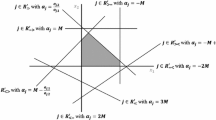Abstract
In many types of linear, convex and nonconvex optimization problems over polyhedra, a global optimal solution can be found by searching the extreme points of the outcome polyhedron Y instead of the extreme points of the decision set polyhedron Z. Since the dimension of Y is often significantly smaller than the dimension of Z, and since the structure of Y is often much simpler than the structure of Z, such an approach has the potential to often yield significant computational savings. This article seeks to motivate these potential savings through both general theory and concrete examples. The article then develops two new procedures. The first procedure is linear-programming based and finds an initial extreme point of an outcome polyhedron Y. The second procedure provides a mechanism for moving from a given extreme point y of Y along any chosen edge of Y emanating from y until a neighboring extreme point to y is reached. As a by-product of the second procedure, as in the pivoting process of the simplex method, a complete algebraic description of the chosen edge can also be easily obtained.
Similar content being viewed by others
References
Bazaraa, M.S., Sherali, H.D. and Shetty, C.M. (1993), Nonlinear Programming: Theory and Algorithms, John Wiley and Sons, New York.
Benson, H.P. (1995), Concave minimization: theory, applications and algorithms, in R. Horst and P.M. Pardalos (eds.), Handbook of Global Optimization, Kluwer Academic Publishers, Dordrecht/Boston/London, pp. 43–148.
Benson, H.P. (1996), Deterministic algorithms for constrained concave minimization: a unified critical survey, Naval Research Logistics 43: 765–795.
Benson, H.P. (1995), A geometrical analysis of the efficient outcome set in multipleobjective convex programs with linear criterion functions, Journal of Global Optimization 6: 231–251.
Benson, H.P. (1998), Pivoting in an outcome polyhedron, Part I: Motivation and initialization, Working Paper July 1998, University of Florida, Department of Decision and Information Sciences, Gainesville, Florida.
Benson, H.P. and Boger, G.M. (1997), Multiplicative programming problems: analysis and efficient point search heuristic, Journal of Optimization Theory and Applications 94: 487–510.
Benson, H.P. and Sun, E. (1998), Pivoting in an outcome polyhedron, Part II: Executing the pivot process, Working Paper July 1998, University of Florida, Department of Decision and Information Sciences, Gainesville, Florida.
Dauer, J.P. (1993), On degeneracy and collapsing in the construction of the set of objective values in a multiple objective linear program, Annals of Operations Research 47: 279–292.
Dauer, J.P. and Liu, Y.H. (1990), Solving multiple objective linear programs in objective space, European Journal of Operational Research 46: 350–357.
Davis, C. (1954), Theory of positive linear dependence, American Journal of Mathematics 76: 733–746.
Falk, J.E. and Palocsay, S.W. (1994), Image space analysis of generalized fractional programs, Journal of Global Optimization 4: 63–88.
Fang, S.-C. and Puthenpura, S. (1993), Linear Optimization and Extensions, Prentice Hall, Englewood Cliffs, New Jersey.
Gal, T. and Geue, F. (1992), A new pivoting rule for solving various degeneracy problems, Operations Research Letters 11: 23–32.
Geue, F. (1993), An improved N-tree algorithm for the enumeration of all neighbors of a degenerate vertex, Annals of Operations Research 47: 361–391.
Horst, R. and Tuy, H. (1993), Global Optimization: Deterministic Approaches, 2nd edition, Springer Verlag, Berlin /New York.
Konno, H. and Kuno, T. (1995), Multiplicative programming problems, in R. Horst and P.M. Pardalos (eds.), Handbook of Global Optimization, Kluwer Academic Publishers, Dordrecht/Boston/London, pp. 369–405.
Konno, H., Thach, P.T. and Tuy, H. (1997), Optimization on Low Rank Nonconvex Structures, Kluwer Academic Publishers, Dordrecht/Boston/London.
Kruse, H.-J. (1986), Degeneracy Graphs and the Neighborhood Problem, Springer Verlag, Berlin /New York.
Martos, B. (1965), The direct power of adjacent vertex programming methods, Management Science 12: 241–252.
Murty, K.G. (1983), Linear Programming, John Wiley and Sons, New York.
Quesada, I. and Grossmann, I. (1995), A global optimization algorithm for linear fractional and bilinear programs, Journal of Global Optimization 6: 39–76.
Rockafellar, R.T. (1970), Convex Analysis, Princeton University Press, Princeton, New Jersey.
Ryoo, H.S. and Sahinidis, N.V. (1996), A branch-and-bound approach to global optimization, Journal of Global Optimization 8: 107–138.
Schaible, S. and Sodini, C. (1995), Finite algorithm for generalized linear multiplicative programming, Journal of Optimization Theory and Applications 87: 441–455.
Steuer, R. (1986), Multiple Criteria Optimization: Theory, Computation, and Application, John Wiley and Sons, New York.
Tuy, H. (1991), Polyhedral annexation, dualization, and dimension reduction technique in global optimization, Journal of Global Optimization 1: 229–244.
Tuy, H. and Tam, B.T. (1992), An efficient solution method for rank-two quasiconcave minimization problems, Optimization 24: 43–56.
Wets, R.J.-B. and Witzgall, C. (1967), Algorithms for frames and lineality spaces of cones, Journal of Research of the National Bureau of Standards 71B: 1–7.
Author information
Authors and Affiliations
Rights and permissions
About this article
Cite this article
Benson, H.P., Sun, E. Pivoting in an Outcome Polyhedron. Journal of Global Optimization 16, 301–323 (2000). https://doi.org/10.1023/A:1008364005245
Issue Date:
DOI: https://doi.org/10.1023/A:1008364005245




